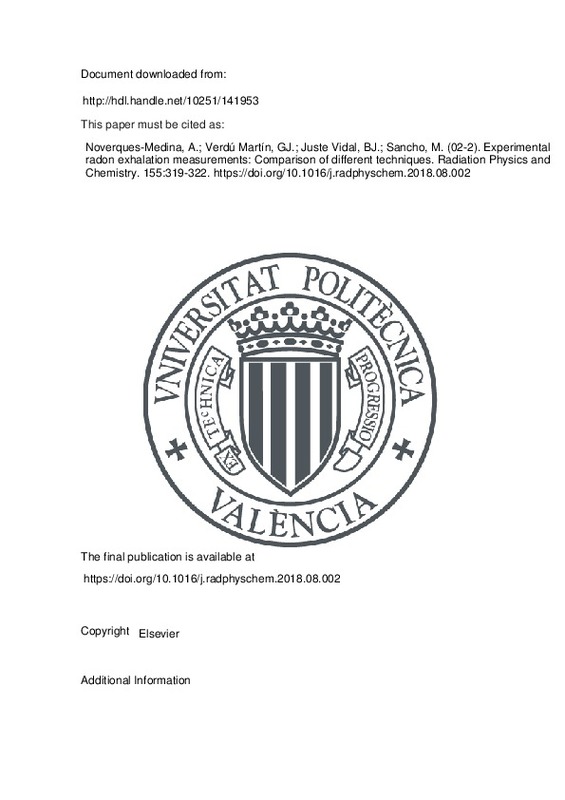JavaScript is disabled for your browser. Some features of this site may not work without it.
Buscar en RiuNet
Listar
Mi cuenta
Estadísticas
Ayuda RiuNet
Admin. UPV
Experimental radon exhalation measurements: Comparison of different techniques
Mostrar el registro sencillo del ítem
Ficheros en el ítem
| dc.contributor.author | Noverques-Medina, Aina
|
es_ES |
| dc.contributor.author | Verdú Martín, Gumersindo Jesús
|
es_ES |
| dc.contributor.author | Juste Vidal, Belen Jeanine
|
es_ES |
| dc.contributor.author | Sancho, M.
|
es_ES |
| dc.date.accessioned | 2020-04-29T07:04:40Z | |
| dc.date.available | 2020-04-29T07:04:40Z | |
| dc.date.issued | 2019-02 | es_ES |
| dc.identifier.issn | 0969-806X | es_ES |
| dc.identifier.uri | http://hdl.handle.net/10251/141953 | |
| dc.description.abstract | [EN] Radon is a gas produced from the radioactive natural disintegration of radium and uranium, which is present in soils and different building materials. Due to its gaseous nature, it emanates to the surface and penetrates both by convection and diffusion into the houses. According to recent studies, radon is considered the second leading cause of lung cancer, and it has prompted legislative changes to reduce exposure to this gas. In Spain, the current legislation -R.D. 783/2001 Regulation on Sanitary Radiation Protection and IS-33 Instruction of the Nuclear Safety Council, establishes uniform rules for workers¿ health protection in radioactive installations. In 2013, the European legislation was updated with Directive 2013/59/EURATOM which sets limit values and action plans for radon exposure for homes, public buildings and workplaces for any entrance roads (soil, building materials or water). This Directive must be incorporated before 18th February 2018 into Spanish legislation, so it is necessary to perform, prior to that date, appropriate protocol techniques and methodologies for the measurement radon concentrations in air. This work aims at a preventive approach to the situation. That is, to measure the concentration levels of radon exhaled prior to the design and construction of the dwellings to avoid their accumulation inside The main purpose of this work is the comparison of different radon exhalation measurement techniques in order to define the most appropriate methodology in different cases for the implementation of the new radon control Directive. | es_ES |
| dc.language | Inglés | es_ES |
| dc.publisher | Elsevier | es_ES |
| dc.relation.ispartof | Radiation Physics and Chemistry | es_ES |
| dc.rights | Reserva de todos los derechos | es_ES |
| dc.subject | Radon | es_ES |
| dc.subject | Exhalation | es_ES |
| dc.subject | Surface emission chamber | es_ES |
| dc.subject | Electret | es_ES |
| dc.subject | Soil gas probe | es_ES |
| dc.subject | Charcoal canister | es_ES |
| dc.subject.classification | INGENIERIA NUCLEAR | es_ES |
| dc.subject.classification | INGENIERIA QUIMICA | es_ES |
| dc.title | Experimental radon exhalation measurements: Comparison of different techniques | es_ES |
| dc.type | Artículo | es_ES |
| dc.identifier.doi | 10.1016/j.radphyschem.2018.08.002 | es_ES |
| dc.rights.accessRights | Abierto | es_ES |
| dc.contributor.affiliation | Universitat Politècnica de València. Departamento de Ingeniería Química y Nuclear - Departament d'Enginyeria Química i Nuclear | es_ES |
| dc.contributor.affiliation | Universitat Politècnica de València. Instituto de Seguridad Industrial, Radiofísica y Medioambiental - Institut de Seguretat Industrial, Radiofísica i Mediambiental | es_ES |
| dc.description.bibliographicCitation | Noverques-Medina, A.; Verdú Martín, GJ.; Juste Vidal, BJ.; Sancho, M. (2019). Experimental radon exhalation measurements: Comparison of different techniques. Radiation Physics and Chemistry. 155:319-322. https://doi.org/10.1016/j.radphyschem.2018.08.002 | es_ES |
| dc.description.accrualMethod | S | es_ES |
| dc.relation.publisherversion | https://doi.org/10.1016/j.radphyschem.2018.08.002 | es_ES |
| dc.description.upvformatpinicio | 319 | es_ES |
| dc.description.upvformatpfin | 322 | es_ES |
| dc.type.version | info:eu-repo/semantics/publishedVersion | es_ES |
| dc.description.volume | 155 | es_ES |
| dc.relation.pasarela | S\382539 | es_ES |







![[Cerrado]](/themes/UPV/images/candado.png)

